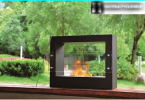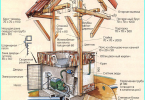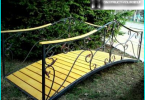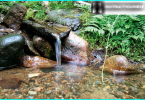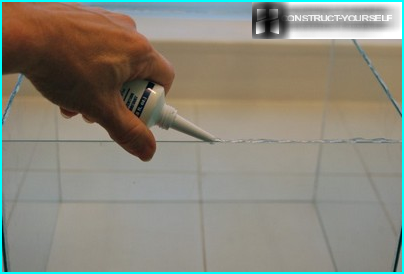
The garden path is necessary on any site. They guard the garden and flower beds from ruin inattentive households allow direct access to the garden even on a rainy day. Made in the same style with other buildings, walkways complement the landscaping of the site, will help correct accents. It is very important to be attentive to their creation to ignorance of a natural garden appeared urban track, more like a sidewalk. Also will look unnatural in the English Park Japanese step-by-step path. To create a path in the right way will help form to fill garden paths. How to make it, we’ll talk.
The contents
Why garden paths use a form?
Indeed, in order to make a path in the garden, you can apply the finished design to look right in the store building materials and to order the right amount.
But the form for garden paths has its own advantages.
- Savings. It is enough to compare the price of the finished tiles and the raw materials from which it is made, how to determine that mix their own solution and pour it into a form of profitable. Don’t have to think how to transport the finished tile, no need to spend money on its shipping and handling.
- The uniqueness. Created with the track is unique: you need the width, length and configuration, taking into account the scale and design of a certain area, which is intended to.
- Usability and reliability. Tiles can be made of any thickness and strength that will allow it to pave the car Park and any other areas of the garden.
- Ease of use. Using the form of the desired configuration, you can create a track on one tile, and whole sections.
- Beauty. Forming your own tile, you can decorate the finished product with pieces of granite or pebbles to make a path element, which further increases the advantages of the garden.
Those who value individuality, who are not accustomed to obey the standards and not always follow the rules, certainly make a choice in favor of self-production of elements of garden paths.

Track made using the form, economical, unique, practical, and the result is pleasing to the eye
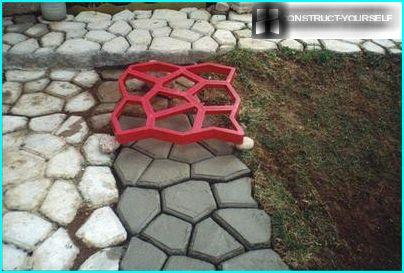
Due to the shape, you can make paths of different lengths, widths and configurations
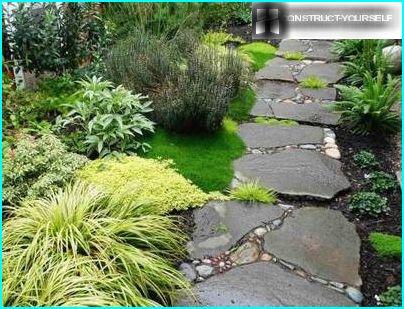
Custom tracks attract attention with their uniqueness
Buy a ready-made form or make it yourself?
Mould for making garden paths made with your own hands, may not give a geometrically accurate elements, but the result is the most natural and copyrighted. For individuality and uniqueness in the world valued things made by hand.
Who said that the shape is hand made it will be worse in-store option? In addition, the money saved a prudent owner will always find what to spend. It’s time to get creative and consider two options for creating their own forms to fill tiles.
Homemade option #1 — form of wooden bars
Four wooden block 50 x 50 mm can fasten together to form the frame. Reliability will give the grooves that are cut in opposing pairs of bars. You can use thin sheet steel in the form of staples, which at the joints of the bars are attached with screws.
The role of the bottom form will play iron sheet or plywood. On the surface of the finished tile these items will look interesting. In the application form, large size tiles, it is better to reinforce a mesh of metal. The front surface can be decorated with pieces of pottery, crushed stone or gravel.
Decorative material you can just lay on the bottom of the mold, but securing water-soluble adhesive on the surface of the paper, and then put it on the bottom of the paper down. Pour cement mortar. With a fixed of tiles remove the form, then warm water wash away the paper. The surface of the product zheleznjat.
Homemade option #2 — form from sheet metal
If the farm has a old wooden barrel strapped with iron hoops, they can be used to simulate natural stone. Enough to bend the metal as you want, and shape for paths can be applied. This method is especially useful if a few hoops. With the shortage of hoops, they can be made from a sheet of galvanized iron. Simply cut the strips at 5 cm and the ends to bend with a hammer like the roof seam. Form for garden paths with his hands ready.
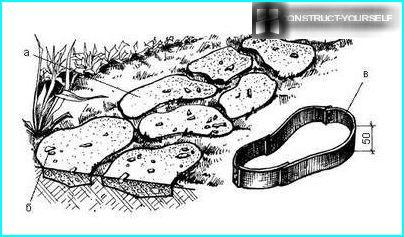
Use of the shape from sheet metal:
a — concrete, b – decorative inclusions in the Hoop
Track with the use of such forms in a special base is not required. They can be created on any surface, if it is not too rocky or swampy. Form is laid out on a prepared base and deepened with a hammer. The soil from the inner region of each Hoop must be removed to a depth of about 5 cm. Formed of the recess and the inner surface of the Hoop must be well moistened after which pour a bit of broken brick or gravel and pour the solution.
To better prepare a solution of 4 parts of sand and one of cement. You can add small gravel filler. It is important not to overdo it with the water: the consistency should be slightly thicker than sour cream. The tile is better to give a small bulge below her dripping. The surface is carefully leveled with a trowel and zheleznjat a mixture of cement and any mineral color.
Grasp the solution very quickly, need to is only a few minutes. Now the Hoop can be removed and reused, while the whole track is ready. To track completely dry, it will take 2-3 days. In case of strong heat, the tile is not cracked, it can be covered with the film.
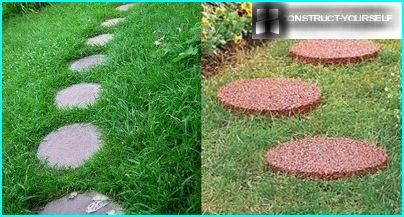
Even a simulated round stones looks good, and adding pigment creates an additional play of color
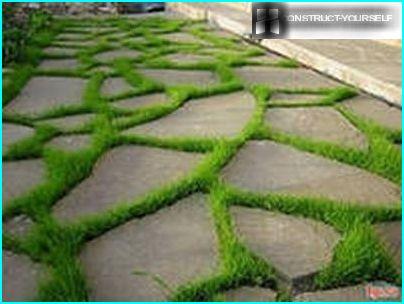
Between the elements of the track, you can use sand or grass
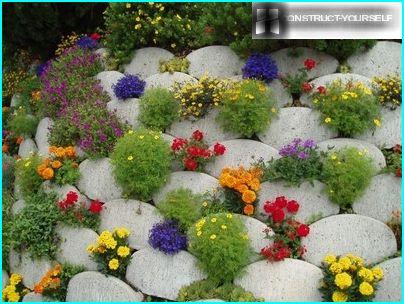
If the track was rebuilt with concrete drives, will always find a new use
By the way, even in the form of circles of concrete carpet original look. In the case of redevelopment, the tiles can be removed from the earth and reused. The gap between the tiles prosypayutsya sand, but will look good and lawn grass. And the solution is to add pigment or decorate the surface of the tiles until she stood, any pattern with a brush or spatula.
The most common curbs
Special fences or curbs give the track a finished appearance. In addition, borders successfully resist the expansion of lawn grass, if this process is undesirable. The lifespan of fenced paths increases. It is important that the border style consistent with the appearance of the track.
Principal of borders:
- Plastic. Perfectly captures the contour of the track. Plastic curb for garden paths match any type of coverage, because practically invisible, which prevents it to be functional.
- Concrete. Used, for example, for a site in the landscape style. Make it the most diverse, depending on the imagination of the designer. They often protect the track from rubble.
- Wooden. Is perfect for footage in a rustic style. With prolonged use, this border is not too presentable, but cheap wooden border make even from scrap boards.
- Brick. Used for country style or English-style garden. This border is capable of beautifully framing sections made of stone blocks or natural boulders.
Below are photo examples of each option.
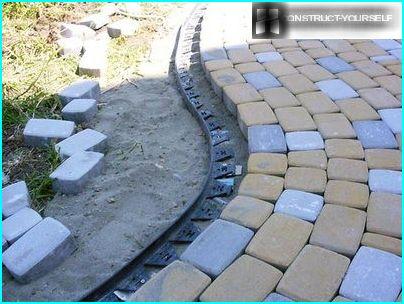
Plastic border is invisible, but perfectly fulfills its function
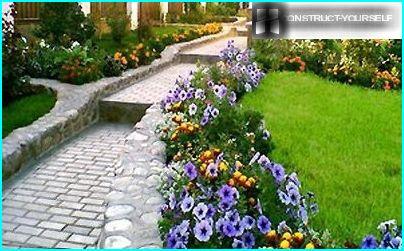
Concrete curb fits perfectly into the landscape style
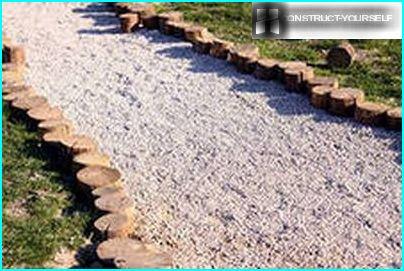
Behind the wooden border maintenance to retain its appearance
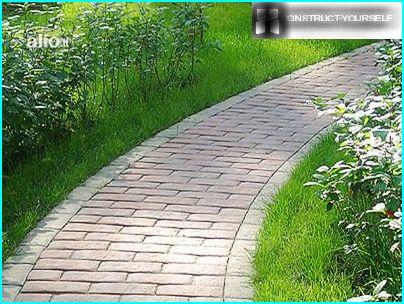
A brick border can decorate the walkway of natural stone or pavers
Made with soul garden path will protect and zone the garden. It will help summer residents to walk freely in any weather. The track will even improve the microclimate of the area heated on Sunny days.


